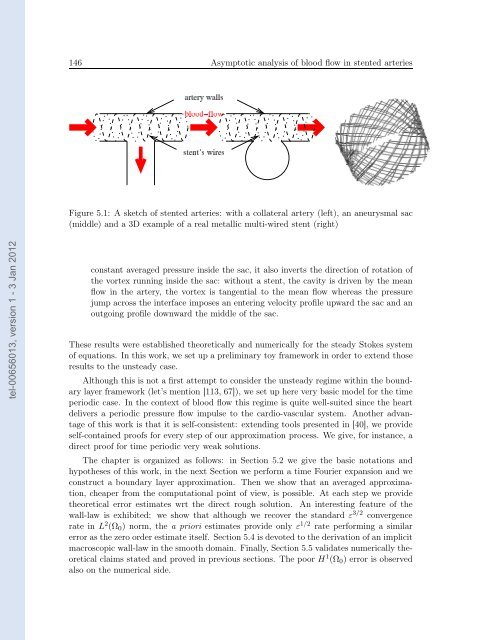Modélisation, analyse mathématique et simulations numériques de ...
Modélisation, analyse mathématique et simulations numériques de ...
Modélisation, analyse mathématique et simulations numériques de ...
You also want an ePaper? Increase the reach of your titles
YUMPU automatically turns print PDFs into web optimized ePapers that Google loves.
tel-00656013, version 1 - 3 Jan 2012<br />
146 Asymptotic analysis of blood flow in stented arteries<br />
Figure 5.1: A sk<strong>et</strong>ch of stented arteries: with a collateral artery (left), an aneurysmal sac<br />
(middle) and a 3D example of a real m<strong>et</strong>allic multi-wired stent (right)<br />
constant averaged pressure insi<strong>de</strong> the sac, it also inverts the direction of rotation of<br />
the vortex running insi<strong>de</strong> the sac: without a stent, the cavity is driven by the mean<br />
flow in the artery, the vortex is tangential to the mean flow whereas the pressure<br />
jump across the interface imposes an entering velocity profile upward the sac and an<br />
outgoing profile downward the middle of the sac.<br />
These results were established theor<strong>et</strong>ically and numerically for the steady Stokes system<br />
of equations. In this work, we s<strong>et</strong> up a preliminary toy framework in or<strong>de</strong>r to extend those<br />
results to the unsteady case.<br />
Although this is not a first attempt to consi<strong>de</strong>r the unsteady regime within the boundary<br />
layer framework (l<strong>et</strong>’s mention [113, 67]), we s<strong>et</strong> up here very basic mo<strong>de</strong>l for the time<br />
periodic case. In the context of blood flow this regime is quite well-suited since the heart<br />
<strong>de</strong>livers a periodic pressure flow impulse to the cardio-vascular system. Another advantage<br />
of this work is that it is self-consistent: extending tools presented in [40], we provi<strong>de</strong><br />
self-contained proofs for every step of our approximation process. We give, for instance, a<br />
direct proof for time periodic very weak solutions.<br />
The chapter is organized as follows: in Section 5.2 we give the basic notations and<br />
hypotheses of this work, in the next Section we perform a time Fourier expansion and we<br />
construct a boundary layer approximation. Then we show that an averaged approximation,<br />
cheaper from the computational point of view, is possible. At each step we provi<strong>de</strong><br />
theor<strong>et</strong>ical error estimates wrt the direct rough solution. An interesting feature of the<br />
wall-law is exhibited: we show that although we recover the standard ε 3/2 convergence<br />
rate in L 2 (Ω0) norm, the a priori estimates provi<strong>de</strong> only ε 1/2 rate performing a similar<br />
error as the zero or<strong>de</strong>r estimate itself. Section 5.4 is <strong>de</strong>voted to the <strong>de</strong>rivation of an implicit<br />
macroscopic wall-law in the smooth domain. Finally, Section 5.5 validates numerically theor<strong>et</strong>ical<br />
claims stated and proved in previous sections. The poor H 1 (Ω0) error is observed<br />
also on the numerical si<strong>de</strong>.

















